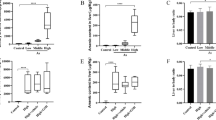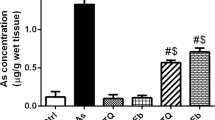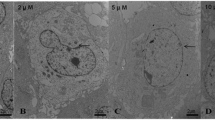Abstract
Oxidative stress plays crucial roles in exerting a variety of damages upon arsenic exposure. Nuclear factor (erythroid-derived 2)-like 2 (Nrf2) is a master transcriptional regulator protecting cells and tissues from oxidative injuries. The objective of this study was to test whether tert-butylhydroquinone (tBHQ), a well-known synthetic Nrf2 inducer, could protect human hepatocytes against arsenic-induced cytotoxicity and oxidative injuries. Our results showed that 5 and 25 μmol/l tBHQ pretreatment suppressed the arsenic-induced hepatocellular cytotoxicity, reactive oxygen species generation, and hepatic lipid peroxidation, while relieved the arsenic-induced disturbances of intracellular glutathione balance. In addition, we also observed that tBHQ treatment promoted the arsenic biomethylation process and upregulated Nrf2-regulated downstream heme oxygenase-1 and NADPH: quinine oxidoreductase 1 mRNA expressions. Collectively, we suspected that Nrf2 signaling pathway may be involved in the protective effects of tBHQ against arsenic invasion in hepatocytes. These data suggest that phenolic Nrf2 inducers, such as tBHQ, represent novel therapeutic or dietary candidates for the population at high risk of arsenic poisoning.



Similar content being viewed by others
References
Sun G, Xu Y, Li X, Jin Y, Li B, Sun X (2007) Urinary arsenic metabolites in children and adults exposed to arsenic in drinking water in Inner Mongolia, China. Environ Health Perspect 115:648–652
Endo H, Sugioka Y, Nakagi Y, Saijo Y, Yoshida T (2008) A novel role of the NRF2 transcription factor in the regulation of arenite-mediated keratin 16 gene expression in human keratinocytes. Environ Health Perspect 116:873–879
Manna P, Sinha M, Sil PC (2008) Arsenic-induced oxidative myocardial injury: protective role of arjunolic acid. Arch Toxicol 82:137–149
Chowdhury R, Chatterjee R, Giri AK, Mandal C, Chaudhuri K (2010) Arsenic-induced cell proliferation is associated with enhanced ROS generation, ErK signaling and CyclinA expression. Toxicol Lett 198:263–271
Flora SJ (2011) Arsenic-induced oxidative stress and its reversibility. Free Radic Biol Med 51:257–281
Jain A, Flora GJ, Bhargava R, Flora SJ (2012) Influence of age on arsenic-induced oxidative stress in rat. Biol Trace Elem Res 149:382–390
Nazıroglu M, Karaoğlu A, Aksoy AO (2004) Selenium and high dose vitamin E administration protects cisplatin-induced oxidative damage to renal, liver and lens tissues in rats. Toxicology 195:221–230
Kockar MC, Nazıroğlu M, Çelik O, Tola HT, Bayram D, Koyu A (2010) N-acetylcysteine modulates doxorubicin-induced oxidative stress and antioxidant vitamin concentrations in liver of rats. Cell Biochem Funct 28:673–677
Chen C, Jiang X, Hu Y, Zhang Z (2013) The protective role of resveratrol in the sodium arsenite-induced oxidative damage via modulation of intracellular GSH homeostasis. Biol Trace Elem Res 155:119–131
Zhang Q, Pi J, Woods CG, Andersen ME (2010) A systems biology perspective on Nrf2-mediated antioxidant response. Toxicol Appl Pharmacol 244:84–97
Blum NM, Mueller K, Lippmann D, Metges CC, Linn T, Pallauf J, Mueller AS (2013) Feeding of selenium alone or in combination with glucoraphanin differentially affects intestinal and hepatic antioxidant and phase II enzymes in growing rats. Biol Trace Elem Res 151:384–399
Magesh S, Chen Y, Hu L (2012) Small molecule modulators of Keap1-Nrf2-ARE pathway as potential preventive and therapeutic agents. Med Res Rev 32:687–726
Kwak MK, Kensler TW (2010) Targeting NRF2 signaling for cancer chemoprevention. Toxicol Appl Pharmacol 244:66–76
Nam KW, Kim YH, Kwon HJ, Rhee SK, Kim WJ, Han MD (2013) Tert-Butylhydroquinone reduces lipid accumulation in C57BL/6 mice with lower body weight gain. Arch Pharm Res 36:897–904
Koh K, Cha Y, Kim S, Kim J (2009) tBHQ inhibits LPS-induced microglial activation via Nrf2-mediated suppression of p38 phosphorylation. Biochem Biophys Res Commun 380:449–453
Hara H, Ohta M, Ohta K, Kuno S, Adachi T (2003) Increase of antioxidative potential by tert-butylhydroquinone protects against cell death associated with 6-hydroxydopamine-induced oxidative stress in neuroblastoma SH-SY5Y cells. Brain Res Mol Brain Res 119:125–131
Pi J, Zhang Q, Woods CG, Wong V, Collins S, Andersen ME (2008) Activation of Nrf2-mediated oxidative stress response in macrophages by hypochlorous acid. Toxicol Appl Pharmacol 226:236–243
Keum YS, Han YH, Liew C, Kim JH, Xu C, Yuan X, Shakarjian MP, Chong S, Kong AN (2006) Induction of heme oxygenase-1 (HO-1) and NAD[P]H: quinone oxidoreductase 1 (NQO1) by a phenolic antioxidant, butylated hydroxyanisole (BHA) and its metabolite, tert-butylhydroquinone (tBHQ) in primary-cultured human and rat hepatocytes. Pharm Res 23:2586–2594
Kann S, Estes C, Reichard JF, Huang MY, Sartor MA, Schwemberger S, Chen Y, Dalton TP, Shertzer HG, Xia Y, Puga A (2005) Butylhydroquinone protects cells genetically deficient in glutathione biosynthesis from arsenite-induced apoptosis without significantly changing their prooxidant status. Toxicol Sci 87:365–384
Chung JS, Haque R, Guha Mazumder DN, Moore LE, Ghosh N, Samanta S, Mitra S, Hira-Smith MM, von Ehrenstein O, Basu A, Liaw J, Smith AH (2006) Blood concentrations of methionine, selenium, beta-carotene, and other micronutrients in a case–control study of arsenic-induced skin lesions in West Bengal, India. Environ Res 101:230–237
Ghatak S, Biswas A, Dhali GK, Chowdhury A, Boyer JL, Santra A (2011) Oxidative stress and hepatic stellate cell activation are key events in arsenic induced liver fibrosis in mice. Toxicol Appl Pharmacol 251:59–69
Li B, Li X, Zhu B, Zhang X, Wang Y, Xu Y, Wang H, Hou Y, Zheng Q, Sun G (2013) Sodium arsenite induced reactive oxygen species generation, nuclear factor (erythroid-2-related) factor 2 activation, heme oxygenase-1 expression, and glutathione elevation in Chang human hepatocytes. Environ Toxicol 28:401–410
Liu D, Duan X, Dong D, Bai C, Li X, Sun G, Li B (2013) Activation of the Nrf2 Pathway by inorganic arsenic in human hepatocytes and the role of transcriptional repressor bach1. Oxidative Med Cell Longev 2013:1–10
Su S, Yang X, Omiecinski CJ (2014) Intronic DNA elements regulate Nrf2 chemical responsiveness of the human microsomal epoxide hydrolase gene (EPHX1) through a far upstream alternative promoter. Biochim Biophys Acta 1839:493–505
Alarcón-Aguilar A, Luna-López A, Ventura-Gallegos JL, LazzariniR G-AS, González-Puertos VY, Morán J, Santamaría A, Königsberg M (2014) Primary cultured astrocytes from old rats are capable to activate the Nrf2 response against MPP+ toxicity after tBHQ pretreatment. Neurobiol Aging 35:1901–1912
Ahmed S, Mahabbat-e Khoda S, Rekha RS, Gardner RM, Ameer SS, Moore S, Ekström EC, Vahter M, Raqib R (2011) Arsenic-associated oxidative stress, inflammation, and immune disruption in human placenta and cord blood. Environ Health Perspect 119:258–264
Cheng WW, Lin ZQ, Wei BF, Zeng Q, Han B, Wei CX, Fan XJ, Hu CL, Liu LH, Huang JH, Yang X, Xi ZG (2011) Single-walled carbon nanotube induction of rat aortic endothelial cell apoptosis: reactive oxygen species are involved in the mitochondrial pathway. Int J Biochem Cell Biol 43:564–572
Weijl NI, Cleton FJ, Osanto S (1997) Free radicals and antioxidants in chemotherapy-induced toxicity. Cancer Treat Rev 23:209–240
Tietze F (1969) Enzymic method for quantitative determination of nanogram amounts of total and oxidized glutathione: applications to mammalian blood and other tissues. Anal Biochem 27:502–522
Bazzichi L, Ciompi ML, Betti L, Rossi A, Melchiorre D, Fiorini M, Giannaccini G (2002) Lucacchini A impaired glutathione reductase activity and levels of collagenase and elastase in synovial fluid in rheumatoid arthritis. Clin Exp Rheumatol 20:761–766
Bradford MM (1976) A rapid and sensitive method for the quantitation of microgram quantities of protein utilizing the principle of protein-dye binding. Anal Biochem 72:248–254
Xu Y, Wang Y, Zheng Q, Li X, Li B, Jin Y, Sun X, Sun G (2008) Association of oxidative stress with arsenic methylation in chronic arsenic-exposed children and adults. Toxicol Appl Pharmacol 232:142–149
Gao S, Duan X, Wang X, Dong D, Liu D, Li X, Sun G, Li B (2013) Curcumin attenuates arsenic-induced hepatic injuries and oxidative stress in experimental mice through activation of Nrf2 pathway, promotion of arsenic methylation and urinary excretion. Food Chem Toxicol 59:739–747
Thomas DJ, Li J, Waters SB, Xing W, Adair BM, Drobna Z, Devesa V, Styblo M (2007) Arsenic (+3 oxidation state) methyltransferase and the methylation of arsenicals. Exp Biol Med 232:3–13
Murugaiyan J, Rockstroh M, Wagner J, Baumann S, Schorsch K, Trump S, Lehmann I, Bergen MV, Tomm JM (2013) Benzo[a]pyrene affects Jurkat T cells in the activated state via the antioxidant response element dependent Nrf2 pathway leading to decreased IL-2 secretion and redirecting glutamine metabolism. Toxicol Appl Pharmacol 269:307–316
Hellou J, Ross NW, Moon TW (2012) Glutathione, glutathione S-transferase, and glutathione conjugates, complementary markers of oxidative stress in aquatic biota. Environ Sci Pollut Res Int 19:2007–2023
Wang XJ, Sun Z, Chen W, Eblin KE, Gandolfi JA, Zhang DD (2007) Nrf2 protects human bladder urothelial cells from arsenite and monomethylarsonous acid toxicity. Toxicol Appl Pharmacol 225:206–213
Valko M, Rhodes CJ, Moncol J, Izakovic M, Mazur M (2006) Free radicals, metals and antioxidants in oxidative stress-induced cancer. Chem Biol Interact 160:1–40
Yan D, Dong J, Sulik KK, Chen SY (2010) Induction of the Nrf2-driven antioxidant response by tert-butylhydroquinone prevents ethanol-induced apoptosis in cranial neural crest cells. Biochem Pharmacol 80:144–14940
Khodagholi F, Tusi SK (2011) Stabilization of Nrf2 by tBHQ prevents LPS-induced apoptosis in differentiated PC12 cells. Mol Cell Biochem 354:97–112
Kong AN, Owuor E, Yu R, Hebbar V, Chen C, Hu R, Mandlekar S (2001) Induction of xenobiotic enzymes by the MAP kinase pathway and the antioxidant or electrophile response element (ARE/EpRE). Drug Metab Rev 33:255–271
Li S, Li J, Shen C, Zhang X, Sun S, Cho M, Sun C, Song Z (2014) tert-Butylhydroquinone (tBHQ) protects hepatocytes against lipotoxicity via inducing autophagy independently of Nrf2 activation. Biochim Biophys Acta 1841:22–33
Arredondo F, Echeverry C, Abin-Carriquiry JA, Blasina F, Antúnez K, Jones DP, Go YM, Liang YL, Dajas F (2010) After cellular internalization, quercetin causes Nrf2 nuclear translocation, increases glutathione levels, and prevents neuronal death against an oxidative insult. Free Radic Biol Med 49:738–747
Kuhn AM, Tzieply N, Schmidt MV, von Knethen A, Namgaladze D, Yamamoto M, Brüne B (2011) Antioxidant signaling via Nrf2 counteracts lipopolysaccharide-mediated inflammatory responses in foam cell macrophages. Free Radic Biol Med 50:1382–1391
Thomas DJ, Nava GM, Cai SY, Boyer JL, Hernández-Zavala A, Gaskins HR (2010) Arsenic (+3 oxidation state) methyltransferase and the methylation of arsenicals in the invertebrate chordate Ciona intestinalis. Toxicol Sci 113:70–76
Marapakala K, Qin J, Rosen BP (2012) Identification of catalytic residues in the As(III) S-adenosylmethionine methyltransferase. Biochemistry 51:944–951
Li X, Li B, Xi S, Zheng Q, Wang D, Sun G (2013) Association of urinary monomethylated arsenic concentration and risk of hypertension: a cross-sectional study from arsenic contaminated areas in northwestern China. Environ Health 12:37
Wu CC, Chen MC, Huang YK, Huang CY, Lai LA, Chung CJ, Shiue HS, Pu YS, Lin YC, Han BC, Wang YH, Hsueh YM (2013) Environmental tobacco smoke and arsenic methylation capacity are associated with urothelial carcinoma. J Formos Med Assoc 112:554–560
Acknowledgments
This study was supported by grants from National Natural Science Foundation of China (NSFC, No. 81172611).
Conflict of Interest
None.
Author information
Authors and Affiliations
Corresponding author
Rights and permissions
About this article
Cite this article
Duan, X., Liu, D., Xing, X. et al. Tert-Butylhydroquinone as a Phenolic Activator of Nrf2 Antagonizes Arsenic-Induced Oxidative Cytotoxicity but Promotes Arsenic Methylation and Detoxication in Human Hepatocyte Cell Line. Biol Trace Elem Res 160, 294–302 (2014). https://doi.org/10.1007/s12011-014-0042-4
Received:
Accepted:
Published:
Issue Date:
DOI: https://doi.org/10.1007/s12011-014-0042-4




